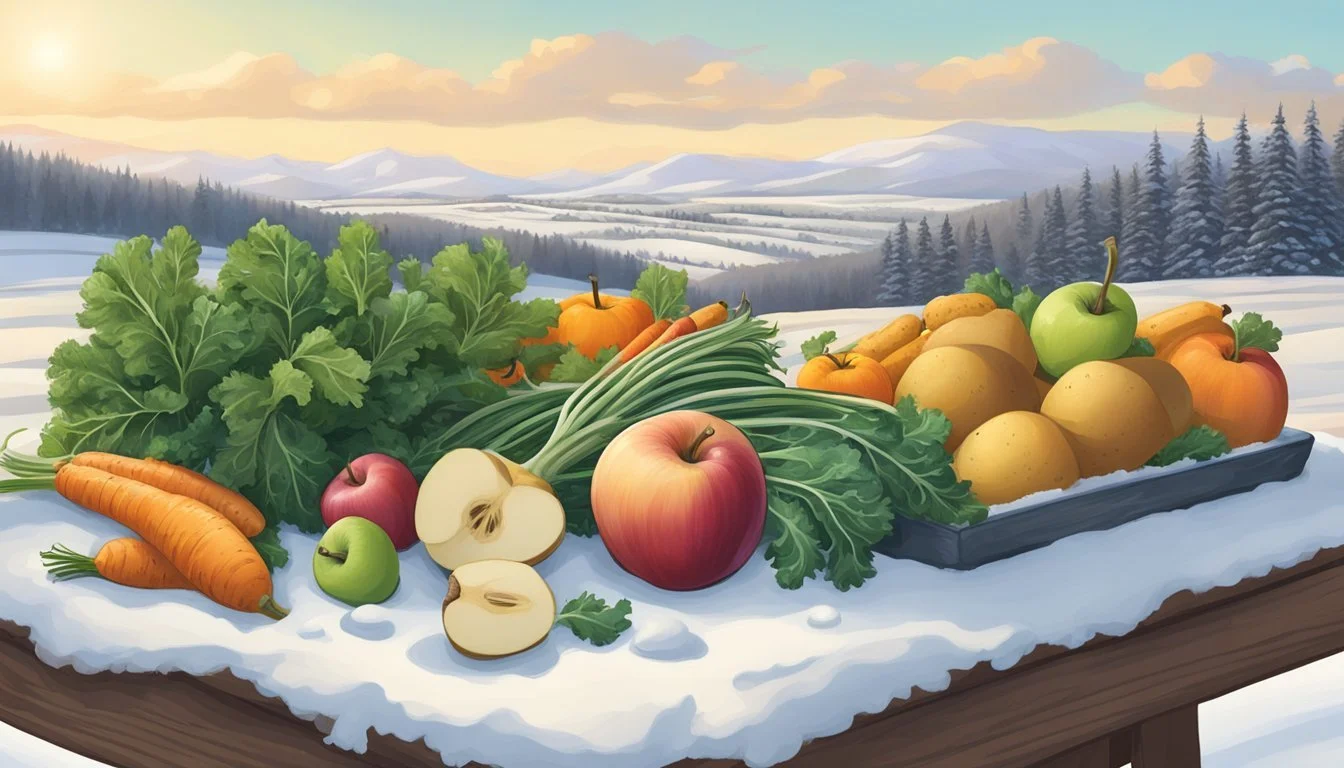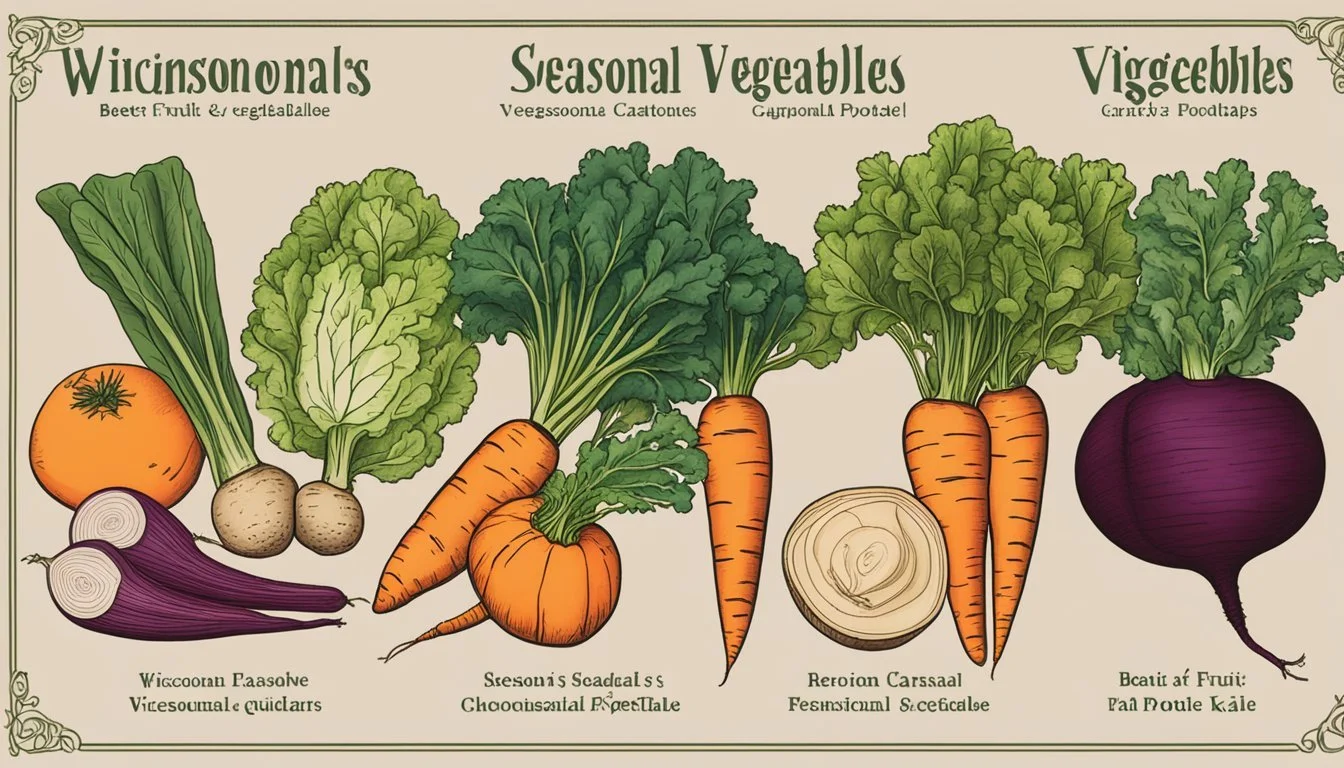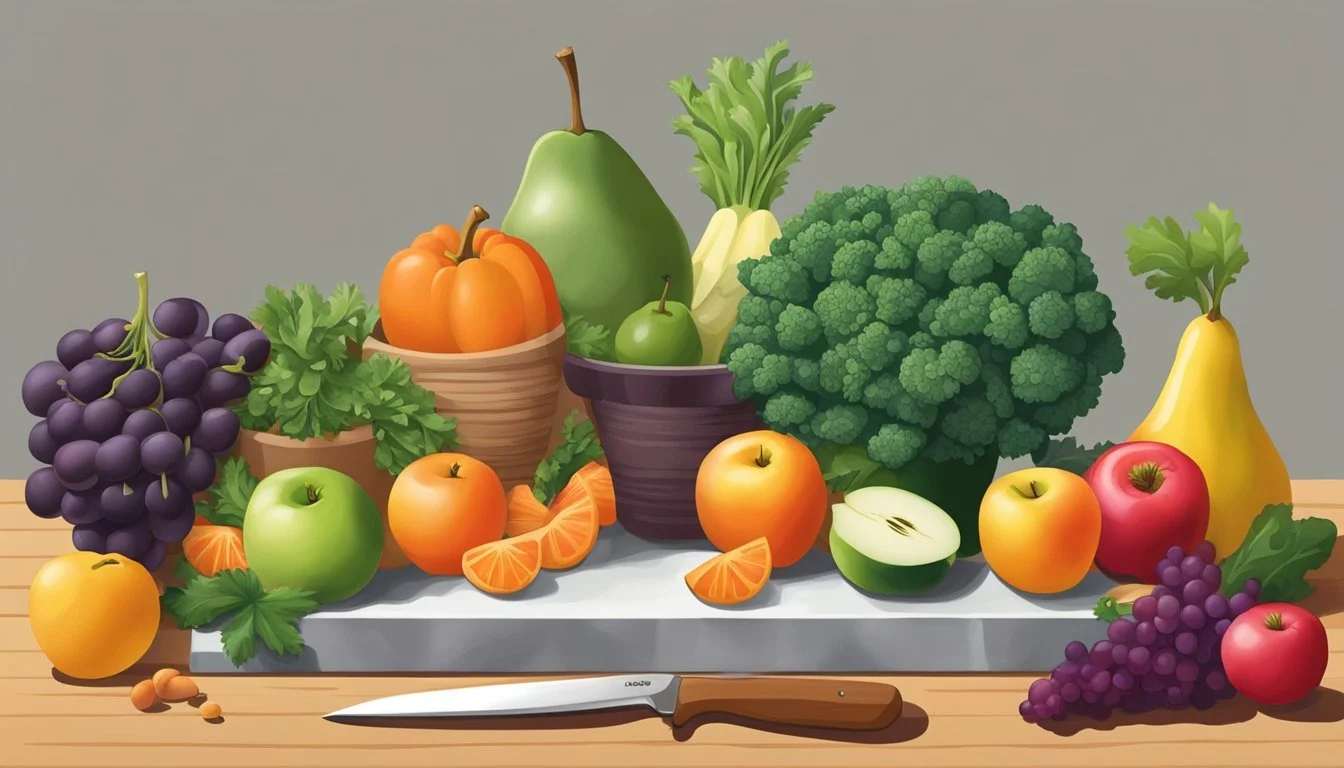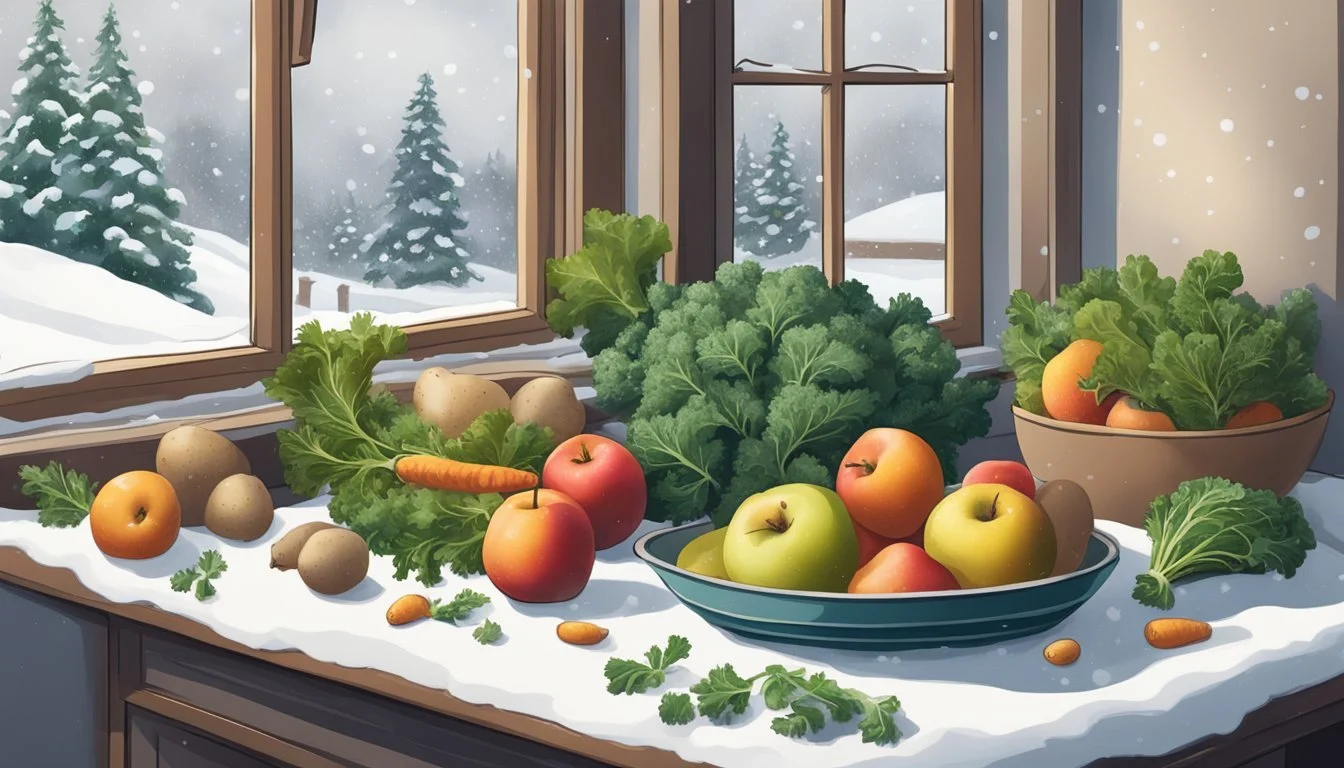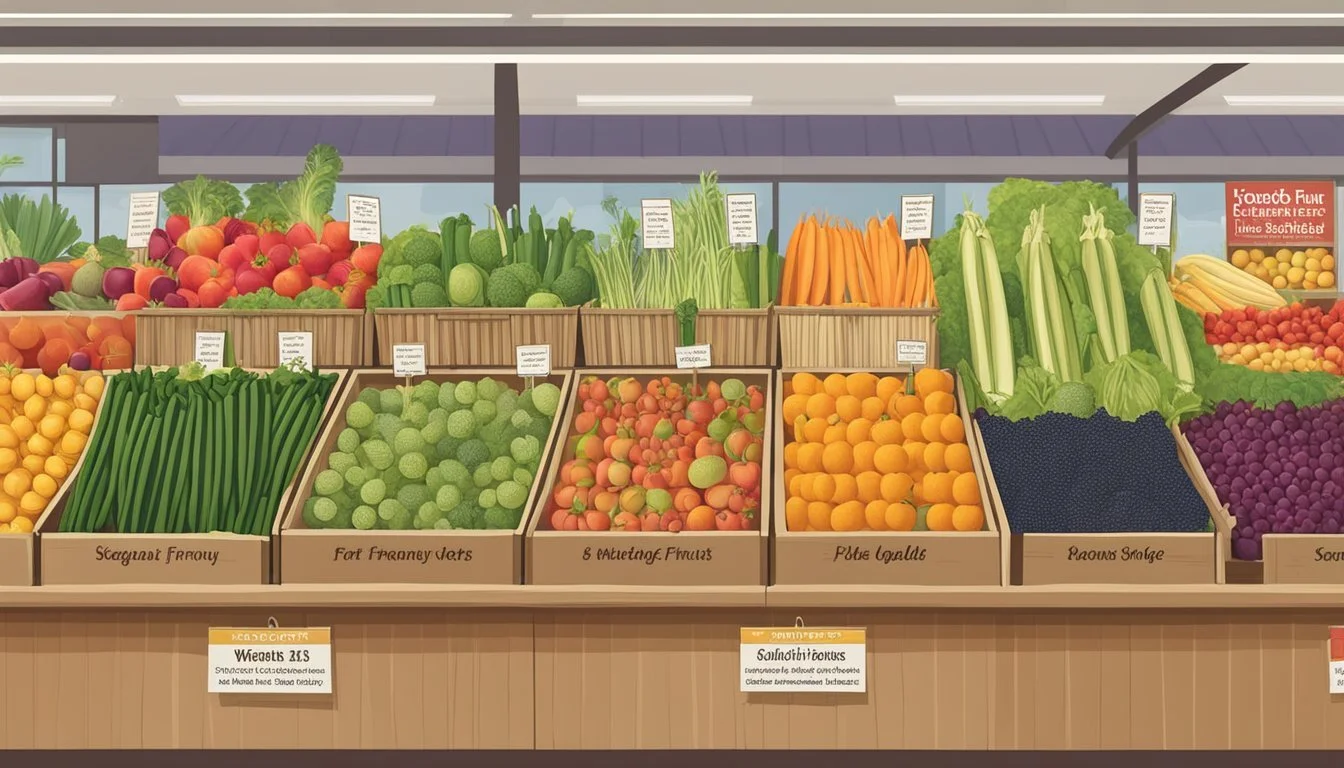Wisconsin Seasonal Fruit & Vegetables in February
Your Guide to Eating Locally
This Article is Part of our Wisconsin Seasonal Fruit & Veg Calendar
In the heart of winter, Wisconsin's agricultural scene adapts to the colder climate, bringing forth a variety of storage crops and the lingering harvests of hardy produce. Although February in Wisconsin may present a stark contrast to the bountiful summer months, residents still have access to a selection of fresh, seasonal fruits and vegetables. These offerings, while more limited than in other seasons, are a testament to the state's commitment to year-round agriculture.
Seasonal produce during this time includes root vegetables and sturdy greens that can withstand Wisconsin's chilly temperatures. Potatoes, carrots (how long do carrots last?), and onions, often stored from fall harvests, continue to feature in local dishes. Meanwhile, cold storage techniques allow for the continued enjoyment of apples and the last vestiges of the cranberry harvest, two crops the state is well known for.
In February, the state's indoor farmers markets and local food cooperatives play an essential role in providing residents with these seasonal selections. The commitment to local produce showcases the resilience of Wisconsin's farming community and offers a taste of the state's agricultural diversity, even during the coldest months.
Seasonal Fruits Overview
In February, Wisconsin's seasonal fruit selection highlights various citrus fruits and cold storage crops like apples. Residents and visitors can enjoy fresh flavors and nutritional benefits during the colder months.
Citrus Fruits Availability
Citrus fruits come to the fore in Wisconsin's February markets. Blood oranges, valued for their deep red flesh and sweet flavor, are readily available. Grapefruits, both the classic and sweeter pink varieties, offer a tart and tangy option. Lemons and oranges continue to brighten winter dishes and provide a burst of vitamin C.
Blood Oranges: Available
Grapefruits: Available
Lemons: Available
Oranges: Available
Storage and Preservation
Due to the cold climate, storage and preservation are key for maintaining fruit freshness. Citrus fruits generally keep well at cool temperatures and should be stored in a refrigerator. For longer-term storage, one can also freeze citrus segments or the juices for later use.
Refrigeration: Best for short-term storage
Freezing: Suitable for long-term preservation
Health Benefits of Seasonal Fruits
Seasonal fruits in February not only offer a respite from the heavier winter fare but also provide significant health benefits. Citrus fruits contribute to a robust immune system with their high vitamin C content. Apples, another staple, are rich in fiber and antioxidants, supporting heart health and aiding digestion. Incorporating these fruits into one's diet can contribute to overall well-being during the winter season.
High Vitamin C: Supports immune function
Rich in Fiber: Benefits digestion and heart health
Antioxidants: Combat oxidative stress
Seasonal Vegetables Guide
In February, Wisconsin's harsh winter climate limits the variety of in-season vegetables. However, there are still various hearty vegetables available that can withstand the cold.
Root Vegetables
Root vegetables thrive in Wisconsin during the winter months. Potatoes, sweet potatoes, and onions are fundamental to the state's seasonal produce in February. These robust vegetables store well and can be used in a multitude of hearty winter recipes.
Potatoes: A versatile staple that can be roasted, mashed, or used in stews.
Sweet Potatoes: Rich in flavor and nutrition, sweet potatoes are ideal for baking and soups.
Leeks: With a milder, sweeter flavor than onions, leeks enhance the taste of winter dishes.
Winter Squash: Stores well and is perfect for baking, providing a comforting sweetness.
Leafy Greens Specification
Despite the chill, some leafy greens are hardy enough to be available in Wisconsin during February. Kale and spinach are notably resilient and provide a fresh taste and a boost of nutrients in winter diets.
Kale: This robust leafy green survives well into the winter and can even become sweeter after a frost.
Spinach: Often available in winter greenhouses or as stored crops, spinach is perfect for salads and cooked dishes.
Cruciferous Vegetables Insights
Cabbage shines as a cruciferous vegetable in Wisconsin's February. It can be stored from the fall harvest and incorporated into a vast array of dishes, from soups and stews to fermented foods (What wine goes well with fermented foods?) like sauerkraut.
Cabbage: A storage-friendly vegetable that is an excellent source of vitamins and can be consumed raw or cooked.
Wisconsin's Growing Season
Wisconsin's growing season is distinct due to its cold climate, leading to a shorter period for crop cultivation and harvest. The state's local produce significantly impacts both the agricultural sector and consumer choices.
Crop Rotation and Timing
In Wisconsin, farmers meticulously plan crop rotation and timing to adapt to the brief growing season. They often commence the growing season with frost-tolerant plants and systematically progress to more temperature-sensitive crops as the weather warms. Key harvest times are adjusted accordingly, ensuring the best use of the land and resources available. For instance, while cranberries and potatoes are usually harvested later, cold-weather crops such as kale and spinach may already be in season.
Local Produce Impact
The impact of local produce in Wisconsin is evident in both economic and community domains. Local produce stands and farmers' markets provide accessibility to fresh, seasonal produce. Moreover, they help in retaining the food dollars within the state, bolstering the local economy. The availability of these seasonal goods varies, with February generally featuring stored crops from the previous season due to the limited fresh produce during this time.
Cooking and Recipes
In February, Wisconsin's seasonal produce inspires a variety of dishes from hearty main courses to fresh side salads and indulgent desserts, making the most of winter flavors.
Main Dishes Featuring February Produce
Wisconsin’s cold February weather calls for comforting main dishes. Root vegetables and hardy greens can be transformed into satisfying meals. One can roast carrots and parsnips to bring out their natural sweetness, serving them alongside a tender, herbed pork loin. Mushrooms, readily available this time of year, lend a rich umami flavor to risottos and stews.
Roasted Vegetable Medley: Incorporate carrots, parsnips, and Brussels sprouts (how long do brussels sprouts last?) with olive oil, salt, and rosemary.
Mushroom Stew: A thick, savory stew with mushrooms, thyme, and a touch of cream.
Side Dishes and Salads
Side dishes in February utilize the robust flavors of winter produce. Salads might feature kale, accented with slices of orange for a refreshing contrast. Roasted Brussels sprouts make an excellent side, perhaps tossed with a balsamic reduction and garnished with toasted nuts for added texture.
Kale and Citrus Salad: Kale, segmented oranges, red onion, and a vinaigrette dressing.
Balsamic Brussels Sprouts: Brussels sprouts roasted and drizzled with a balsamic glaze and served with crunchy walnuts.
Seasonal Desserts and Sweet Treats
Desserts in February can feature the brightness of citrus or the deep, earthy sweetness of cooked fruits and root vegetables. Oranges and lemons can be used in cakes or be converted into zesty marmalades. Sweet desserts, like carrot cake, utilize the natural sugars in seasonal vegetables, delivering a moist, dense flavor profile perfect for this time of year.
Citrus Infused Cakes: Lemon zest (how long does lemon zest last?) and orange juice provide a pop of flavor in a tender, buttery cake.
Carrot Cake: A spiced carrot cake with cream cheese frosting, featuring walnuts or pecans (how long do pecans last?) for added crunch.
Food Pairing and Culinary Tips
In the chilly month of February, Wisconsin's culinary scene leans heavily on storage crops and hearty vegetables. The emphasis is on creating warming dishes that pair well with robust cheeses and are enhanced by the right herbs and spices.
Cheese and Produce Pairing
Wisconsin, known as America's Dairyland, is famous for its cheese, making cheese and produce pairings essential for any winter meal. Here are two key pairings:
Broccoli (how long does broccoli last?)and Cheddar: A classic combination, Wisconsin cheddar brings out the earthy tones of broccoli. Whether in a creamy soup or a broccoli-cheddar bake, the two are a comforting match.
Cauliflower and Gouda: Mild cauliflower pairs wonderfully with the nutty, caramel-sweet notes of smoked Gouda. Try them roasted together or in a gratin.
Herbs and Spices Combinations
Pairing seasonal produce with herbs and spices elevates the natural flavors of the vegetables. Some excellent combinations include:
Carrots and Coriander: The sweet, slightly citrusy profile of coriander complements the natural sweetness of carrots beautifully. Consider adding coriander to a carrot puree or roast.
Brussels Sprouts and Garlic: Roasted Brussels sprouts gain a pleasant kick when tossed with garlic. Finish with a squeeze of lemon to brighten the dish.
Incorporating these pairings into recipes provides both a comforting and flavorful eating experience during Wisconsin’s colder months.
Sustainable Agriculture in Wisconsin
Wisconsin's agricultural sector is increasingly embracing sustainable practices, focusing on soil health, biodiversity, and resource conservation. This shift not only contributes to a healthier environment but also supports long-term economic viability for local farmers.
Organic Farming Practices
In Wisconsin, organic farming is a key component of the state's sustainable agricultural methods. Organic practices aim to maintain ecological balance, and farmers in this region implement techniques such as crop rotation, green manures, and biological pest control. These methods enhance soil fertility and foster biodiversity, which are crucial for sustainable agriculture.
Crop Rotation: Alternating the types of crops grown in each field to avoid depleting soil nutrients.
Green Manures: Planting cover crops like clover or alfalfa to add organic matter to the soil when plowed under.
Biological Pest Control: Using natural predators to manage pest populations without harmful chemicals.
Local Farming Communities
Wisconsin’s local farming communities are central to the promotion of sustainable agriculture. They often converge at farmers markets, where they can share knowledge about sustainable techniques and build connections with consumers. These markets not only serve as hubs for selling produce but also play a vital role in educating the public about the importance of supporting local, sustainable agriculture.
List of Benefits Provided by Local Farmers Markets:
Direct support for local farmers and their sustainable practices.
Fresher, seasonally available produce for consumers.
A platform for farmers to discuss and improve sustainable agriculture methods.
By investing in organic farming practices and supporting local farming communities, Wisconsin continues to be a leader in promoting agricultural sustainability. This approach benefits not only the state's economy but also its environment and residents, ensuring a resilient food system for future generations.
Seasonal Eating and Nutrition
Eating seasonally in February in Wisconsin can enhance one's diet with nutritious winter crops that thrive in the cold months. Seasonal produce usually offers higher nutrient content and a greater diversity of vitamins and minerals essential for a balanced diet.
Balanced Diet with Seasonal Produce
A balanced diet benefits from the inclusion of seasonal fruits and vegetables due to their freshness and nutritional peak. In February, Wisconsin offers a range of winter crops, such as stored root vegetables and hearty greens, that are essential for maintaining a healthy diet during the colder months. These crops are a source of complex carbohydrates, fiber, and a variety of vitamins and minerals.
Root Vegetables: Rich in fiber and vitamins like vitamin C and vitamin B6.
Hearty Greens: Such as kale and Swiss chard, which provide vitamins A, C, and K.
Incorporating these seasonal items helps support local agriculture and ensures that one consumes produce when it's at its optimal nutritional value.
Nutritional Information of Winter Crops
The nutritional profile of winter crops is robust, offering an array of health benefits:
Root Vegetables (e.g., potatoes, carrots, beets):
Potatoes: High in potassium, vitamin C, and vitamin B6.
Carrots: Excellent source of beta-carotene, fiber, vitamin K1, and antioxidants.
Beets: Contain folate, manganese, and nitrates which are beneficial for blood pressure.
Hearty Greens:
Kale: Packed with vitamins A, K, C, and B6, as well as calcium and potassium.
Swiss Chard: Offers vitamin K, A, and C, as well as minerals like magnesium and iron.
Utilizing these winter crops in daily meals contributes to immune function, energy levels, and overall well-being, proving the importance of seasonal eating for both community health and personal nutrition.
Marketing and Social Media
In Wisconsin, marketing efforts for seasonal produce have taken a creative turn through the use of social media platforms. These efforts aim to enhance community engagement and promote healthy eating habits by showcasing recipes and local produce.
Promoting Seasonal Produce on Social Platforms
Marketing strategies in Wisconsin harness popular social media channels such as Twitter, Facebook, and Pinterest to reach diverse audiences. Campaigns are tailored to highlight Wisconsin's seasonal fruits and vegetables, inviting consumers to engage with the content. On Twitter, the use of hashtags allows the promotion of seasonal produce to spread rapidly, engaging consumers in real-time. Facebook's targeted ads and community groups leverage algorithms to pinpoint interested demographics, providing vital information about where and when to find fresh, local produce.
Pinterest Recipes and Facebook Communities
Pinterest provides a rich visual platform where users find and share seasonal recipes. Each pin links back to blogs or websites, offering detailed information on how to prepare seasonal fruits and vegetables from Wisconsin.
Facebook communities play an integral role in creating a network of local producers and consumers. Groups tailored to Wisconsin produce offer a space to share experiences, recipes, and tips for selecting and storing fresh produce. These groups strengthen the sense of community and support local agriculture.
Through concerted marketing and social media initiatives, Wisconsin's producers connect with consumers to foster a greater appreciation for seasonal produce. This strategy not only boosts local agribusiness but also promotes healthier lifestyles within the community.

